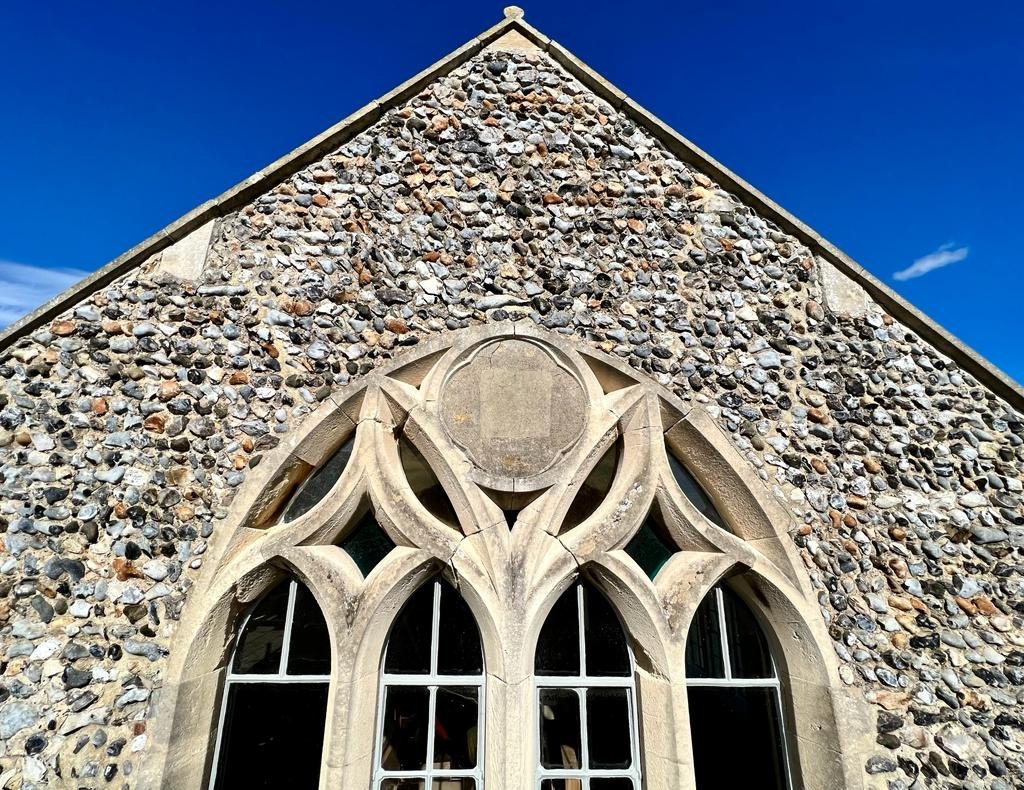From School to Studio
The Old School in Garlinge is an eye-catching landmark nestled in the centre of the village. Clad in vernacular Kentish flint with limestone block work, its material palette and symmetrical form are synonymous with the Victorian period during which it was built. In recent times local residents became familiar with plywood shuttering boards covering the windows and doors during a period of dereliction and closure. But all that began to change in 2021 when artist Alex Calinescu bought the building at auction, and now it has been lovingly restored to create a beautiful home and studio.
The school originally opened its doors in 1854 after a 2-year construction, which cost a grand total of £606 funded by the church and local residents. It was run by St John’s Church of Margate and initially consisted of a single hall space, which was subdivided into 2 identical rooms via a large curtain. Pupils entered through two doorways, with boys residing on one side and girls separately on the other. By 1864 it played host to fifty students and in 1872, the same year that Garlinge became a separate parish, an additional hall of similar proportions was added and also used as a Sunday school. However, by 1930 the modest pair of halls could no longer accommodate the growing number of children in the village and a new school was built. In the proceeding years, the space was used as a church hall and utilised by numerous community groups, with a third storage space added onto the back of the building that for many years included the well-stocked (and fortified) Scout tuck shop.
It’s a building that evokes a visceral sense of its past both inside and out, something that then London-based Alex noted and fell in love with even when in a state of disrepair. Having searched for many years for a building near the sea in which to create a new home and studio, she had first seen the Old School online a full year before only to find that it was under offer at the time. In February 2021, whilst searching again, she spotted that it was up for auction in a few days time. Five days later, stepping inside for the first time, Alex immediately felt a sense of peace and knew this was where she was meant to be. Her determination, and perhaps a dollop of fate, led to her coming out as the highest bidder and so the journey of transformation and indeed becoming a permanent Thanet resident began.
It was not a decision she took lightly, and she quickly sought to bring the space back to life and show the community her positive intentions for it, which she remembers hitting home when taking the shutters down, “Letting the sunlight back into the building after years of neglect and abandonment was very special and, for me, a powerful metaphor. As each shutter came down, the light increased inside the Old School and we breathed together.” Although equally symbolically, the very first thing Alex did was to begin planting in the 3 garden spaces that flank the building, “Starting with an Acer tree, and then a magnolia. It was my sense of wanting to give something back to the local community and to literally feel myself putting down roots.”
Having patiently waited for the approval of a change of usage application, work on the inside began - and there was much to be done. But all that hard work has paid off because on entering the space, through new solid timber front doors, the vaulted ceilings and open plan nature of the freshly converted old classrooms takes your breath away. Both the original and secondary halls are light and airy, yet warm and cosy; imposingly grand in scale yet understated and welcoming in feel. Each has a selection of instantly alluring handmade objet of all shapes and sizes, which are carefully curated and displayed. They speak of an owner with a discerning eye - a keen collector of fine ceramics and sumptuously carved wooden sculpture. But then, of course, there’s Alex’s own large-scale artwork, which adorns a number of the walls and tells the story of a prolific painter and printmaker whose career spans some thirty-six years.
It’s therefore the third space, the studio, that Alex spends the most time in. A huge racking system covers one wall and is chockablock with works ranging from large to very large, while the walls each contained a massive painting during my visit. Like many artists, Alex is reticent to explain the paintings and bestow her own sense of meaning upon them, but her abstract canvases are always awash with merging colour that is applied while they lay on the ground and are moved and manipulated over time. It’s a very physical exercise in painting - in every sense - and the elements, music, contemporary dance and nature have long been integral sources of inspiration for her work. The resulting paintings imbue a sense of fluidity and mystery, inspiring thoughts of extreme landscapes, deep oceans, frozen surfaces, trails of vapor, and even interstellar space - all in one viewing.
The spirit of the work feels fitting for an artist who lives close to the vast sea and skies of Margate, and they are not lost on Alex, “Take me to the sea and I instantly feel at home, and at peace. I’ve always loved being beneath huge skies, watching the line between sky and sea shift from the extreme of a hard edge to something indiscernible. There is something utterly mesmerizing about this that I cannot explain.” Even when inside her new live-work space, the light from outside continues to beam in through the ancient church-style windows, shimmering and fluttering across the walls, captured for a moment before moving again. The hallowed halls gently pulse with a calming serenity and if you listen carefully you can’t help but sense the jubilant echo of laughter as children run playfully through the space. A perfect place to paint, and to make a home.
Alex Calinescu’s exhibition, ‘Into the Light’, is open until 29th September 2024,by appointment. www.alexcalinescu.com
To find out more about Alex’s work visit www.alexcalinescu.com and check her out on Instagram @alexcalinescu.artist
This article was first published by Design Insider.





